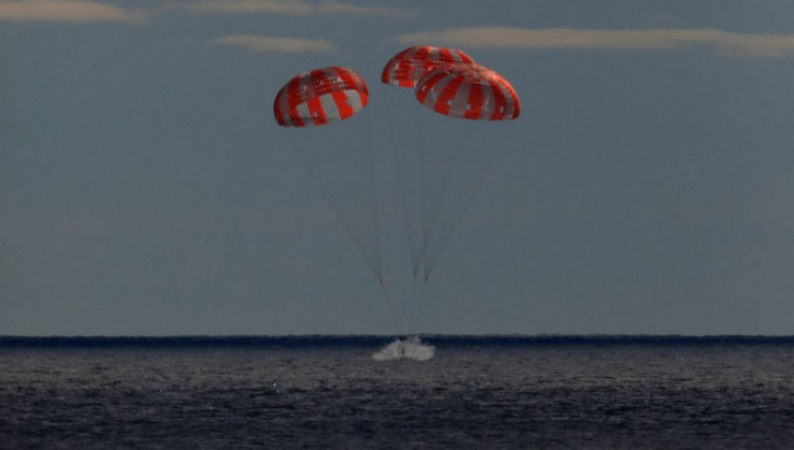
CAPE CANAVERAL: In a test flight that should pave the way for astronauts on the following lunar flybys, NASA's Orion capsule made a surprisingly quick return from the Moon on Sunday. It then parachuted into the Pacific Ocean off Mexico.
The incoming capsule experienced reentry temperatures of 5,000 °F (2,760 °C) and slammed into the atmosphere at Mach 32, or 32 times the speed of sound, before splashdown west of Baja California near Guadalupe Island.
The spacecraft's three silent occupants, test dummies outfitted with vibration sensors and radiation monitors, were quickly rescued by a Navy ship.
Also Read: 27 bodies from Ethiopia have been found, according to Zambian police
The descent and splashdown were praised by NASA as nearly flawless, and congratulated from Washington.
"I'm overwhelmed," NASA Administrator Bill Nelson told Mission Control in Houston. "It's a remarkable day ... It's historic because a new generation will travel into deep space for the first time.
The next Orion flight around the Moon, scheduled for 2024 and featuring four astronauts whose identities will be revealed early next year, depended on a successful splashdown for the space agency to stay on schedule.
Then, in early 2025, two people will land on the Moon, and eventually a permanent lunar base will be established. The long-term goal is to send an expedition to Mars by the late 2030s.
Astronauts stepped on the moon for the last time in 1950. The longest stay of the Apollo era was by Apollo 17's Eugene Cernan and Harrison Schmitt, who spent three days exploring the Taurus-Littrow Valley after touching down on December 11, 1972. He was the last of the 12 Moonwalkers.
Orion launched on NASA's brand new Mega Moon rocket from Kennedy Space Center on November 16, becoming the first spacecraft to visit the Moon since then.
It was the inaugural flight of NASA's brand new Artemis Moon program, named in honor of Apollo's mythical twin sister.
Also Read: Jersey fire death toll rises to 5; 4 remain missing
The most recent phase of NASA's mission to the Moon ends with stops at Tranquility Base, Taurus-Littrow and Serene Pacific. Mission Control commentator Rob Navias said, "Orion is back on Earth.
Even though no one was on the $4 billion test flight, NASA managers were pleased that the dress rehearsal went off without a hitch, especially after so many years of flight delays and over budgets. The storm and fuel spill caused further delays in late summer and early fall.
In a nod to the Apollo era, NASA held a splashdown celebration at Houston's Johnson Space Center on Sunday, inviting staff members and their families to attend. The visitor center next door hosted a party for the general public.
NASA's main goal was to bring Orion back after a 25-day journey. The capsule used a brand new, state-of-the-art heat shield that had never been tested on a spacecraft as it returned at 25,000 mph (40,000 kph), faster than coming from low Earth orbit. Very fast. It plunged into the atmosphere to reduce gravity or G-weight and briefly floated out; This also helped in identifying the splashdown location.
Officials noted that everything happened superbly to ensure Orion's safe return.
Mission Manager Mike Sarafin declared, "I don't think any of us could have imagined a mission this successful.
Once Orion is back at Kennedy by the end of the month, additional observations will be made. NASA will select the first lunar crew from among the 42 active American astronauts stationed at Houston's Johnson Space Center in early 2023 if capsule inspections do not come up with problems.
"We know people are concerned," Johnson's director Vanessa Wiech told reporters. "The American people would like to know about these astronauts, like [the original seven astronauts in the Mercury days]," Nelson continued.
More than 300 miles (482 kilometers) south of the initial target area, the capsule splashed down. NASA changed the location due to forecasts of rough seas and strong winds off the Southern California coast.
Also Read: Serbs are blocking roads in north Kosovo, raising tensions
Orion traveled 1.4 million miles (2.25 million kilometers) as it reached the Moon, where it spent about a week in a wide, swooping orbit before returning to Earth.
Twice, it passed the Moon within 80 miles (130 km). The capsule traveled more than 268,000 miles (430,000 km) above Earth at its greatest distance.
Beautiful images of both the home planet and the moon's gray, cratered surface were returned by Orion. The mission team was in awe when the capsule's final image, Earthrise, showed a crescent Earth.
The flight's numerous accomplishments, according to astronomer Daniel Brown from Nottingham Trent University, demonstrate NASA's capacity to send astronauts on the following Artemis moonshot.
For NASA's Orion spacecraft, this was the exciting conclusion to a remarkable and significant journey, according to a statement from Brown in England.
Never before has the moon been hotter. Earlier on Sunday, a spacecraft launched from Cape Canaveral in the direction of the moon.
The lunar lander is owned by ispace, a Tokyo-based business looking to establish an economy there. In the meantime, lunar landers from two American companies will take off early in 2019.